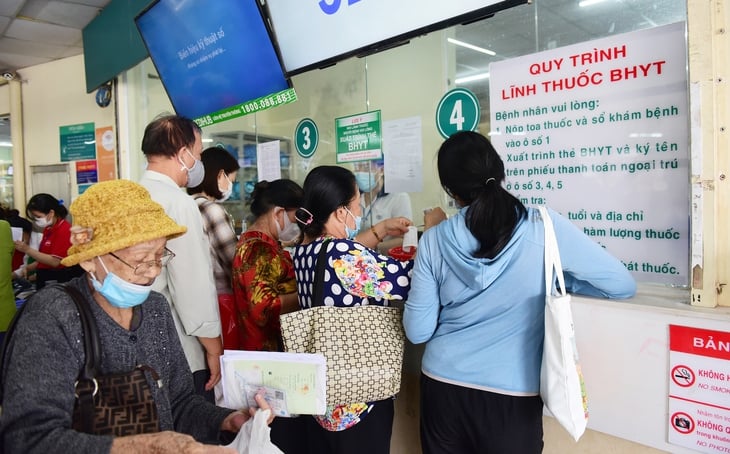Patients waiting to receive insurance medicine at a hospital - Photo: DUYEN PHAN
Tuoi Tre had an interview with Mr. Vuong Anh Duong, Deputy Director of the Department of Medical Examination and Treatment Management, about the development of a list of chronic diseases that are provided with long-term medication and the concerns and solutions to implement this policy.
200 diseases in the list
* Why did the Ministry of Health decide to change the regulation on prescription time from a maximum of 30 days to 90 days?
- Previously, Circular 52/2017 stipulated that outpatient prescriptions should be for a maximum of 30 days, but in practice, especially for stable chronic diseases, the need to extend the duration of medication use is justified.
The Ministry of Health has allowed the provision of 3-month medication during the COVID-19 period, when patients could not visit the hospital regularly. The results showed that this brought many advantages such as reducing the burden on medical facilities, reducing the time and travel costs of patients, especially in remote areas, while still ensuring treatment effectiveness.
The issuance of a list of diseases that can be prescribed for 30 to 90 days is a policy that the health sector is interested in. Chronic diseases are not only the familiar diseases of hypertension and diabetes, but the actual list of chronic diseases is very diverse.
Therefore, we have carefully considered the list of chronic diseases that can be prescribed for a long time, extending the maximum prescription period. The top priority is not only the convenience for patients, reducing travel costs, reducing the burden on hospitals, but also the safety of patients.
* How is the list of diseases prescribed for 90 days selected? Is it completed, sir?
- To build this list, we consulted 20 end-line hospitals, in many different specialties such as geriatrics, pediatrics, endocrinology... After the hospitals proposed, we organized an appraisal through professional councils.
The Ministry of Health requires end-line hospitals of each specialty to make a list of proposals and to provide strict evaluation criteria. Hospitals specifically analyze the risks: increased costs for each prescription; patients do not have the conditions to ensure the quality of the medicine; are not closely monitored for unwanted effects during use; or in case the disease progresses, the regimen needs to be changed; patients die before using up all the medicine, causing waste...
To date, we have had about 200 diseases in the proposed list, including not only hypertension, diabetes, COPD, mental disorders... but also a series of endocrine, cardiovascular, and neurological diseases. For example, the group of infectious and parasitic diseases including chronic hepatitis B, HIV/AIDS, are considered diseases that need close monitoring but stable treatment, and can extend the drug collection cycle.
In the group of blood and immune diseases, the expanded list includes Thalassemia, sickle cell anemia, hereditary and acquired hemolytic anemias, bone marrow failure, bringing great benefits to patients, especially children on long-term supportive treatment.
Endocrine diseases such as hypothyroidism, thyrotoxicosis, and hypoparathyroidism are also updated to include extended prescriptions, helping patients reduce the burden of traveling and monthly check-ups.
Notably, many chronic degenerative neurological and psychiatric diseases such as dementia, Alzheimer's, Parkinson's, and amyotrophic lateral sclerosis are also included in the list of drugs that will be extended. In particular, gynecological diseases in adolescents such as menorrhagia during puberty are also given attention in this adjustment.
Expanding this list not only helps patients with chronic diseases to receive treatment more conveniently, but also helps reduce the burden on frontline medical facilities, while ensuring good control of chronic diseases and rare diseases in the community.
Mr. Vuong Anh Duong
Based on the patient's specific condition
* So, do all patients with chronic diseases on the list get a maximum of 90 days of medication?
- Right when creating this list, we determined that extending the prescription period was a very careful matter, because the highest goal was to ensure the health and safety of patients.
Therefore, not every disease in the list is prescribed for 90 days by default. The doctor will have to base on the specific condition of each patient to decide how many days to prescribe.
The new circular also stipulates that prescribers must base on the diagnosis and condition of the patient to decide the quantity of medicine prescribed, the number of days of use of each medicine in the prescription, and are responsible for their decisions.
The number of days of medication supply will vary from 30 to 90 days depending on the disease code. In case the medication has not been used up, the disease has abnormal developments or the patient cannot return for a follow-up visit on time, the patient needs to go to the medical facility for a re-examination and treatment adjustment.
We hope that people do not misunderstand that being on the list means being given long-term medication by default. Each doctor is responsible for each prescription and must anticipate the risks that may occur during the patient's treatment at home.
* According to you, what needs to be done to ensure long-term safety in providing medicine?
- To ensure patient safety, doctors still need to ensure the principles of safe treatment, avoid drug abuse or let patients have complications that are not detected in time. People also need to be instructed by doctors to self-monitor and detect early side effects of drugs (if any) and need to monitor their health, take medication as directed so that the disease does not become serious.
In addition, providing medicine for 3 months may also increase the cost of medical examination and treatment under health insurance. Regarding this issue, the Department will discuss further with the Vietnam Social Security to have appropriate instructions for hospitals when implementing.
The circular is expected to be issued on July 1. The Department of Medical Examination and Treatment Management will provide training and specific instructions to medical facilities for synchronous implementation.
Make it easier for the sick.
The Ministry of Health is discussing the possibility of providing longer-term medication for chronic patients, which is good news for tens of thousands of patients who have to go to the hospital to get medication every month. Most of them are elderly, have difficulty moving around, and have to have their children take them and wait at least half a day for each monthly medication, even some hospitals only provide 21 days of medication per session, which is difficult for them. They have complained many times but the situation... remains the same and this time there is hope for change.
Talking about the family having an elderly mother with a chronic illness and facing difficulties, a patient's family member said that her mother had 4 diseases: diabetes, blood pressure, arthritis and Alzheimer's. According to regulations, to receive insurance medicine, she had to have a check-up every month, and each time she went for a check-up, she had to wait a long time just to see the doctor for a few minutes.
And it's not easy to take my mother back to the doctor because she has to stop taking her blood pressure and diabetes medication in the morning and skip breakfast, while diabetic patients need to take their medication and eat breakfast on time.
Every time she goes to the doctor, the family has to wake up early in the morning to prepare diapers, milk, and food in case she has to wait too long and her blood sugar drops. After the examination and blood test, they quickly find a convenient place to give her medicine and breakfast...
So even though she can get the right insurance medicine, her family usually only takes her to the hospital once a year, the rest of the time she sees a private doctor and goes to the pharmacy to buy prescription medicine, so the insurance is useless!
Now she is hoping for a policy to examine chronic patients like her mother remotely, or to allow insurance to recognize test results from private doctors, thereby providing medicine to chronic patients who have difficulty traveling, so that patients with insurance do not have to buy expensive medicine outside while they clearly have health insurance.
Speaking to Tuoi Tre, a leader of Vietnam Social Security said that the agency has repeatedly proposed providing longer-term medication for chronic patients, both to reduce travel and waiting time for patients and to reduce the burden on medical facilities.
Through the reality during the COVID-19 pandemic as well as the recent pilot at Xanh Pon Hospital, Hanoi , it shows that providing 2-3 months of medication for chronic patients who have been treated stably for 6 months to 1 year shows that the rate of patients having to return for early re-examination due to needing to change medication or having complications is only about 3% (the figure at Xanh Pon Hospital), the rest are safe, showing that this can be done.
However, the problem of not being able to provide longer-term medication for patients comes from the current regulations of the Ministry of Health and the requirement to only allow medication to be provided for less than 30 days. From this regulation, some hospitals apply 15 days for one period, some places 21 days, some places exactly 30 days. Therefore, chronic patients who want to receive medication have to go back and forth many times, have to wait, and some people even wait so long that they have to go home without receiving medication.
Currently, 93% of the population has health insurance, so insurance-related policies are related to almost everyone. In addition to how to make hospitals provide high-tech services and better treatment quality, related medical services such as providing medicine to patients more conveniently are issues that need to be promoted, thereby making it easier for patients, especially the elderly and the sick, to have any difficulty.
This has been talked about for at least the past two years, and now it seems to be coming to its expected conclusion: patients will be given longer-term medication, while still receiving scheduled checkups and health monitoring.
This time, we wait for the Ministry of Health to make a decision to reduce the difficulties of the patients. Any relief for them would be good.
WILLOW - RED RIVER
Source: https://tuoitre.vn/lap-danh-muc-benh-benh-nhan-man-tinh-se-duoc-cap-thuoc-toi-da-3-thang-lan-20250605215857424.htm




























































































![[OCOP REVIEW] Tu Duyen Syrup - The essence of herbs from the mountains and forests of Nhu Thanh](https://vphoto.vietnam.vn/thumb/402x226/vietnam/resource/IMAGE/2025/6/5/58ca32fce4ec44039e444fbfae7e75ec)






Comment (0)